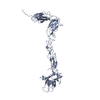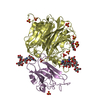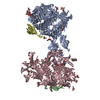[English] 日本語
 Yorodumi
Yorodumi- PDB-4bkf: crystal structure of the human EphA4 ectodomain in complex with h... -
+ Open data
Open data
- Basic information
Basic information
| Entry | Database: PDB / ID: 4bkf | ||||||
|---|---|---|---|---|---|---|---|
| Title | crystal structure of the human EphA4 ectodomain in complex with human ephrinB3 | ||||||
 Components Components |
| ||||||
 Keywords Keywords |  TRANSFERASE / TRANSFERASE /  CELL ADHESION / CELL REPULSION / RECEPTOR CLUSTERING / RECEPTOR CIS INTERACTION / ERYTHROPOETIN-PRODUCING HEPATOCELLULAR RECEPTOR / LBD / CELL ADHESION / CELL REPULSION / RECEPTOR CLUSTERING / RECEPTOR CIS INTERACTION / ERYTHROPOETIN-PRODUCING HEPATOCELLULAR RECEPTOR / LBD /  SUSHI / EGF / FN SUSHI / EGF / FN | ||||||
| Function / homology |  Function and homology information Function and homology informationaxon choice point recognition / trans-synaptic signaling by trans-synaptic complex, modulating synaptic transmission /  DH domain binding / : / neuron projection fasciculation / positive regulation of Rho guanyl-nucleotide exchange factor activity / corticospinal tract morphogenesis / regulation of astrocyte differentiation / negative regulation of proteolysis involved in protein catabolic process / : ...axon choice point recognition / trans-synaptic signaling by trans-synaptic complex, modulating synaptic transmission / DH domain binding / : / neuron projection fasciculation / positive regulation of Rho guanyl-nucleotide exchange factor activity / corticospinal tract morphogenesis / regulation of astrocyte differentiation / negative regulation of proteolysis involved in protein catabolic process / : ...axon choice point recognition / trans-synaptic signaling by trans-synaptic complex, modulating synaptic transmission /  DH domain binding / : / neuron projection fasciculation / positive regulation of Rho guanyl-nucleotide exchange factor activity / corticospinal tract morphogenesis / regulation of astrocyte differentiation / negative regulation of proteolysis involved in protein catabolic process / : / neuron projection guidance / nephric duct morphogenesis / regulation of synapse pruning / fasciculation of sensory neuron axon / fasciculation of motor neuron axon / synapse pruning / negative regulation of cellular response to hypoxia / negative regulation of axon regeneration / positive regulation of aspartic-type endopeptidase activity involved in amyloid precursor protein catabolic process / glial cell migration / negative regulation of axonogenesis / transmembrane-ephrin receptor activity / DH domain binding / : / neuron projection fasciculation / positive regulation of Rho guanyl-nucleotide exchange factor activity / corticospinal tract morphogenesis / regulation of astrocyte differentiation / negative regulation of proteolysis involved in protein catabolic process / : / neuron projection guidance / nephric duct morphogenesis / regulation of synapse pruning / fasciculation of sensory neuron axon / fasciculation of motor neuron axon / synapse pruning / negative regulation of cellular response to hypoxia / negative regulation of axon regeneration / positive regulation of aspartic-type endopeptidase activity involved in amyloid precursor protein catabolic process / glial cell migration / negative regulation of axonogenesis / transmembrane-ephrin receptor activity /  PH domain binding / GPI-linked ephrin receptor activity / regulation of modification of synaptic structure / negative regulation of epithelial to mesenchymal transition / regulation of dendritic spine morphogenesis / negative regulation of cell adhesion / motor neuron axon guidance / adult walking behavior / adherens junction organization / positive regulation of dendrite morphogenesis / EPH-Ephrin signaling / Ephrin signaling / PH domain binding / GPI-linked ephrin receptor activity / regulation of modification of synaptic structure / negative regulation of epithelial to mesenchymal transition / regulation of dendritic spine morphogenesis / negative regulation of cell adhesion / motor neuron axon guidance / adult walking behavior / adherens junction organization / positive regulation of dendrite morphogenesis / EPH-Ephrin signaling / Ephrin signaling /  Somitogenesis / Somitogenesis /  regulation of axonogenesis / positive regulation of amyloid-beta formation / cochlea development / regulation of axonogenesis / positive regulation of amyloid-beta formation / cochlea development /  regulation of GTPase activity / EPHA-mediated growth cone collapse / plasma membrane => GO:0005886 / negative regulation of long-term synaptic potentiation / EPH-ephrin mediated repulsion of cells / positive regulation of cell adhesion / ephrin receptor signaling pathway / positive regulation of protein tyrosine kinase activity / axon terminus / axonal growth cone / EPHB-mediated forward signaling / regulation of GTPase activity / EPHA-mediated growth cone collapse / plasma membrane => GO:0005886 / negative regulation of long-term synaptic potentiation / EPH-ephrin mediated repulsion of cells / positive regulation of cell adhesion / ephrin receptor signaling pathway / positive regulation of protein tyrosine kinase activity / axon terminus / axonal growth cone / EPHB-mediated forward signaling /  protein tyrosine kinase binding / T cell costimulation / hippocampal mossy fiber to CA3 synapse / protein tyrosine kinase binding / T cell costimulation / hippocampal mossy fiber to CA3 synapse /  ephrin receptor binding / negative regulation of cell migration / dendritic shaft / ephrin receptor binding / negative regulation of cell migration / dendritic shaft /  filopodium / filopodium /  axon guidance / postsynaptic density membrane / axon guidance / postsynaptic density membrane /  adherens junction / Schaffer collateral - CA1 synapse / adherens junction / Schaffer collateral - CA1 synapse /  neuromuscular junction / negative regulation of ERK1 and ERK2 cascade / neuromuscular junction / negative regulation of ERK1 and ERK2 cascade /  receptor protein-tyrosine kinase / peptidyl-tyrosine phosphorylation / cellular response to amyloid-beta / negative regulation of neuron projection development / virus receptor activity / cell-cell signaling / receptor protein-tyrosine kinase / peptidyl-tyrosine phosphorylation / cellular response to amyloid-beta / negative regulation of neuron projection development / virus receptor activity / cell-cell signaling /  presynaptic membrane / presynaptic membrane /  nervous system development / nervous system development /  amyloid-beta binding / amyloid-beta binding /  kinase activity / kinase activity /  perikaryon / early endosome membrane / perikaryon / early endosome membrane /  protein tyrosine kinase activity / mitochondrial outer membrane / negative regulation of translation / protein tyrosine kinase activity / mitochondrial outer membrane / negative regulation of translation /  dendritic spine / protein autophosphorylation / protein stabilization / dendritic spine / protein autophosphorylation / protein stabilization /  cell adhesion / cell adhesion /  protein kinase activity / positive regulation of cell migration / protein kinase activity / positive regulation of cell migration /  axon / axon /  dendrite / glutamatergic synapse / positive regulation of cell population proliferation / dendrite / glutamatergic synapse / positive regulation of cell population proliferation /  cell surface / cell surface /  ATP binding / identical protein binding / ATP binding / identical protein binding /  plasma membrane / plasma membrane /  cytoplasm cytoplasmSimilarity search - Function | ||||||
| Biological species |   HOMO SAPIENS (human) HOMO SAPIENS (human) | ||||||
| Method |  X-RAY DIFFRACTION / X-RAY DIFFRACTION /  SYNCHROTRON / SYNCHROTRON /  MOLECULAR REPLACEMENT / Resolution: 4.65 Å MOLECULAR REPLACEMENT / Resolution: 4.65 Å | ||||||
 Authors Authors | Seiradake, E. / Schaupp, A. / del Toro Ruiz, D. / Kaufmann, R. / Mitakidis, N. / Harlos, K. / Aricescu, A.R. / Klein, R. / Jones, E.Y. | ||||||
 Citation Citation |  Journal: Nat.Struct.Mol.Biol. / Year: 2013 Journal: Nat.Struct.Mol.Biol. / Year: 2013Title: Structurally Encoded Intraclass Differences in Epha Clusters Drive Distinct Cell Responses Authors: Seiradake, E. / Schaupp, A. / Del Toro Ruiz, D. / Kaufmann, R. / Mitakidis, N. / Harlos, K. / Aricescu, A.R. / Klein, R. / Jones, E.Y. | ||||||
| History |
|
- Structure visualization
Structure visualization
| Structure viewer | Molecule:  Molmil Molmil Jmol/JSmol Jmol/JSmol |
|---|
- Downloads & links
Downloads & links
- Download
Download
| PDBx/mmCIF format |  4bkf.cif.gz 4bkf.cif.gz | 526.6 KB | Display |  PDBx/mmCIF format PDBx/mmCIF format |
|---|---|---|---|---|
| PDB format |  pdb4bkf.ent.gz pdb4bkf.ent.gz | 441.9 KB | Display |  PDB format PDB format |
| PDBx/mmJSON format |  4bkf.json.gz 4bkf.json.gz | Tree view |  PDBx/mmJSON format PDBx/mmJSON format | |
| Others |  Other downloads Other downloads |
-Validation report
| Arichive directory |  https://data.pdbj.org/pub/pdb/validation_reports/bk/4bkf https://data.pdbj.org/pub/pdb/validation_reports/bk/4bkf ftp://data.pdbj.org/pub/pdb/validation_reports/bk/4bkf ftp://data.pdbj.org/pub/pdb/validation_reports/bk/4bkf | HTTPS FTP |
|---|
-Related structure data
| Related structure data |  4bk4SC  4bk5C  4bkaC  3d12S S: Starting model for refinement C: citing same article ( |
|---|---|
| Similar structure data |
- Links
Links
- Assembly
Assembly
| Deposited unit | 
| ||||||||
|---|---|---|---|---|---|---|---|---|---|
| 1 |
| ||||||||
| Unit cell |
|
- Components
Components
| #1: Protein | Mass: 62679.359 Da / Num. of mol.: 2 / Fragment: HEPHA4 ECTODOMAIN, RESIDUES 20-547 Source method: isolated from a genetically manipulated source Source: (gene. exp.)   HOMO SAPIENS (human) / Plasmid: PHLSEC / Cell line (production host): HEK293T / Production host: HOMO SAPIENS (human) / Plasmid: PHLSEC / Cell line (production host): HEK293T / Production host:   HOMO SAPIENS (human) HOMO SAPIENS (human)References: UniProt: P54764,  receptor protein-tyrosine kinase receptor protein-tyrosine kinase#2: Protein | Mass: 20404.375 Da / Num. of mol.: 2 Fragment: HEPHRINA5 RECEPTOR BINDING DOMAIN, RESIDUES 27-169 Source method: isolated from a genetically manipulated source Source: (gene. exp.)   HOMO SAPIENS (human) / Plasmid: PHLSEC / Cell line (production host): HEK293T / Production host: HOMO SAPIENS (human) / Plasmid: PHLSEC / Cell line (production host): HEK293T / Production host:   HOMO SAPIENS (human) / References: UniProt: Q15768 HOMO SAPIENS (human) / References: UniProt: Q15768Sequence details | SEQUENCE CORRESPONDS TO HEPHA4 RESIDUES 20-547 FUSED TO AN N-TERMINAL SECRETION SIGNAL SEQUENCE AND ...SEQUENCE CORRESPOND | |
|---|
-Experimental details
-Experiment
| Experiment | Method:  X-RAY DIFFRACTION X-RAY DIFFRACTION |
|---|
- Sample preparation
Sample preparation
| Crystal | Density % sol: 83.3 % Description: WE USED THE CC CRITERIA TO SELECT THE HIGH RESOLUTION CUT-OFF. THE CC-HALF VALUE IN THE HIGHERST RESOLUTION SHELL IS 16.1. |
|---|---|
Crystal grow | Details: PROTEIN SAMPLE WAS MIXED 1:1:1 (V/V/V) WITH (0.08 M MAGNESIUM ACETATE TETRAHYDRATE. 0.05 M CACODYLATE PH 6.5, 15% POLYETHYLENE GLYCOL 400) AND 0.1 M SPERMIDINE (HAMPTON). |
-Data collection
| Diffraction |
| |||||||||||||||
|---|---|---|---|---|---|---|---|---|---|---|---|---|---|---|---|---|
| Diffraction source |
| |||||||||||||||
| Detector |
| |||||||||||||||
| Radiation |
| |||||||||||||||
| Radiation wavelength | Wavelength : 0.9173 Å / Relative weight: 1 : 0.9173 Å / Relative weight: 1 | |||||||||||||||
| Reflection | Resolution: 4.65→106 Å / Num. obs: 25557 / % possible obs: 99.9 % / Observed criterion σ(I): 0 / Redundancy: 10.8 % / Biso Wilson estimate: 220.26 Å2 / Rmerge(I) obs: 0.26 / Net I/σ(I): 7.7 | |||||||||||||||
| Reflection shell | Resolution: 4.65→4.7 Å / Redundancy: 6.9 % / Mean I/σ(I) obs: 0.5 / % possible all: 99.9 |
- Processing
Processing
| Software |
| ||||||||||||||||||||||||||||||||||||||||||||||||||||||||||||||||||||||||||||||||||||||||||||||||||||||||||||||||||
|---|---|---|---|---|---|---|---|---|---|---|---|---|---|---|---|---|---|---|---|---|---|---|---|---|---|---|---|---|---|---|---|---|---|---|---|---|---|---|---|---|---|---|---|---|---|---|---|---|---|---|---|---|---|---|---|---|---|---|---|---|---|---|---|---|---|---|---|---|---|---|---|---|---|---|---|---|---|---|---|---|---|---|---|---|---|---|---|---|---|---|---|---|---|---|---|---|---|---|---|---|---|---|---|---|---|---|---|---|---|---|---|---|---|---|---|
| Refinement | Method to determine structure : :  MOLECULAR REPLACEMENT MOLECULAR REPLACEMENTStarting model: PDB ENTRIES 4BK4, 3D12 Resolution: 4.65→106.25 Å / Cor.coef. Fo:Fc: 0.8642 / Cor.coef. Fo:Fc free: 0.9053 / Cross valid method: THROUGHOUT / σ(F): 0 / SU Rfree Blow DPI: 1.014 Details: ONLY RIGID BODY AND TLS REFIN MOLECULAR REPLACEMENT, DUE TO THE LOW RESOLUTION.
| ||||||||||||||||||||||||||||||||||||||||||||||||||||||||||||||||||||||||||||||||||||||||||||||||||||||||||||||||||
| Displacement parameters | Biso mean: 209.75 Å2
| ||||||||||||||||||||||||||||||||||||||||||||||||||||||||||||||||||||||||||||||||||||||||||||||||||||||||||||||||||
| Refine analyze | Luzzati coordinate error obs: 1.895 Å | ||||||||||||||||||||||||||||||||||||||||||||||||||||||||||||||||||||||||||||||||||||||||||||||||||||||||||||||||||
| Refinement step | Cycle: LAST / Resolution: 4.65→106.25 Å
| ||||||||||||||||||||||||||||||||||||||||||||||||||||||||||||||||||||||||||||||||||||||||||||||||||||||||||||||||||
| Refine LS restraints |
| ||||||||||||||||||||||||||||||||||||||||||||||||||||||||||||||||||||||||||||||||||||||||||||||||||||||||||||||||||
| LS refinement shell | Resolution: 4.65→4.84 Å / Total num. of bins used: 13
|
 Movie
Movie Controller
Controller







 PDBj
PDBj









